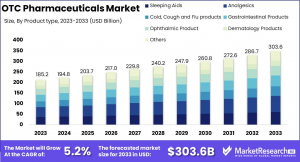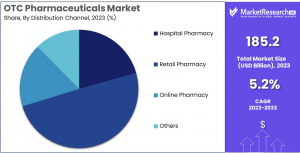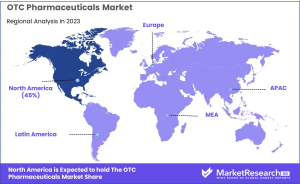OTC Pharmaceuticals Market to Experience Steady Growth, Projected to Achieve USD 303.6 Billion by 2033
The Global OTC Pharmaceuticals Market was valued at USD 185.2 Bn in 2023. It is expected to reach USD 303.6 Bn by 2033, with a CAGR of 5.2%
By Distribution Channel In the OTC pharmaceuticals market, retail pharmacy emerges as the dominating distribution channel, capturing approximately 60% of the market share.”
NEW YORK, NY, UNITED STATES, February 17, 2025 /EINPresswire.com/ -- Overview— Tajammul Pangarkar
The Global OTC Pharmaceuticals Market was valued at USD 185.2 Bn in 2023. It is expected to reach USD 303.6 Bn by 2033, with a CAGR of 5.2% during the forecast period from 2024 to 2033.
Over-the-Counter (OTC) pharmaceuticals play a vital role in modern healthcare by offering convenient, accessible, and cost-effective treatment options for common ailments. These medications, available without a prescription, help manage conditions such as pain, colds, allergies, digestive issues, and skin conditions. The market continues to expand as consumers seek self-care solutions and greater control over their health.
Regulatory bodies such as the U.S. Food and Drug Administration (FDA) and the European Medicines Agency (EMA) ensure the safety, efficacy, and proper labeling of OTC products. Advances in formulation, digital health integration, and e-commerce platforms are further driving market growth.
With rising consumer awareness and increasing healthcare costs, OTC medications provide a trusted, first-line treatment for millions globally. Companies are investing in innovation, personalized healthcare solutions, and sustainable packaging to meet evolving consumer needs. As self-medication trends grow, OTC pharmaceuticals remain a key pillar of preventive and accessible healthcare worldwide.
Click here to get a Sample report copy @ https://marketresearch.biz/report/otc-pharmaceuticals-market/request-sample/
Key Takeaways
•Market Growth: The Global OTC Pharmaceuticals Market was valued at USD 185.2 billion in 2023 and is projected to reach USD 303.6 billion by 2033, growing at a CAGR of 5.2% from 2024 to 2033. The market’s expansion is driven by increasing self-medication trends and rising consumer awareness of accessible healthcare solutions.
•By Product Type: Analgesics lead the market, accounting for 25% of total sales, driven by growing demand for pain relief medications. These products play a crucial role in the widespread adoption of OTC pharmaceuticals.
•By End-Users: The homecare segment dominates the OTC pharmaceuticals market, holding 40% of the market share, as consumers prioritize self-care and at-home treatment solutions.
•By Distribution Channel: Retail pharmacies remain the dominant distribution channel, capturing approximately 60% of the market share, supported by widespread availability and trusted consumer access.
•Regional Dominance: North America leads the global OTC pharmaceuticals market, holding 45% of the total market share, driven by a strong healthcare infrastructure and high consumer preference for self-medication.
•Growth Opportunity: Expanding digital platforms to improve consumer education and access presents a major growth opportunity. Specialized OTC segments like dermatology and ophthalmic treatments can benefit from digital innovations, catering to modern healthcare needs.
Segmentation Analysis
•By Product Type: Analgesics dominate the OTC pharmaceuticals market, accounting for 25% of total sales due to their widespread use in pain relief. Their accessibility and effectiveness make them a preferred choice for consumers managing headaches, muscle pain, and joint discomfort. The dual benefit of pain relief and sleep enhancement has also increased their adoption in sleeping aid formulations. Continuous advancements in analgesic formulations and easy availability across pharmacies, online platforms, and healthcare facilities contribute to their strong market presence.
•By End-Users: Homecare is the leading end-user segment in the OTC pharmaceuticals market, holding 40% of the market share. The growing preference for self-care solutions and easy access to OTC medications drive this trend. Consumers favor home-based treatments for managing minor illnesses, reducing healthcare visits. The convenience, cost-effectiveness, and availability of OTC products at retail stores and online platforms further strengthen homecare’s dominance. As self-medication trends rise, homecare remains a crucial segment shaping the market’s future.
•By Distribution Channel: Retail pharmacies lead the OTC pharmaceuticals market, capturing approximately 60% of the market share. Their widespread presence, easy accessibility, and trusted reputation make them the primary choice for purchasing OTC medications. Retail pharmacies offer a broad selection of products, from pain relievers to digestive health solutions, catering to diverse consumer needs. The integration of digital tools, home delivery options, and pharmacist consultations further enhances customer convenience, reinforcing retail pharmacies as the dominant distribution channel.
Market Segments
By Product type
•Sleeping Aids
•Analgesics
•Cold, Cough and Flu products
•Gastrointestinal Products
•Ophthalmic Product
•Dermatology Products
•Others
By End-Users
•Speciality Clinic
•Homecare
•Hospital
•Others
By Distribution Channel
•Hospital Pharmacy
•Retail Pharmacy
•Online Pharmacy
•Others
To Purchase this Premium Report @ https://marketresearch.biz/purchase-report/?report_id=45548
Market Dynamics
•Driver: The increasing consumer inclination towards self-care and preventive health measures has significantly propelled the over-the-counter (OTC) pharmaceuticals market. This trend is driven by a desire for autonomy in health management and the convenience of accessing medications without a prescription. Regulatory frameworks, such as the U.S. Food and Drug Administration's (FDA) OTC monograph system, facilitate the availability of safe and effective OTC products, thereby supporting market growth.
•Trend: A notable trend in the OTC pharmaceuticals market is the modernization of regulatory processes to keep pace with evolving healthcare needs. The FDA's implementation of the Over-the-Counter Monograph User Fee Program aims to streamline the review and approval of OTC products, ensuring timely access to innovative and safe medications for consumers. This initiative reflects a broader movement towards regulatory efficiency and responsiveness in the healthcare sector.
•Restraint: Despite the benefits, the OTC pharmaceuticals market faces challenges related to drug shortages, often stemming from quality issues in manufacturing. The FDA has identified that a significant number of drug shortages are due to quality problems, highlighting the need for robust quality management systems among manufacturers. These shortages can limit the availability of essential OTC medications, impacting consumer access and trust.
•Opportunity: The integration of digital health technologies presents a substantial opportunity for the OTC pharmaceuticals market. Leveraging online platforms and mobile applications can enhance consumer education, facilitate access to OTC products, and promote responsible self-medication practices. This digital shift aligns with the increasing consumer demand for convenient and informed healthcare solutions, potentially expanding market reach and engagement.
Market Key Players
•Mylan N.V.
•DAIICHI SANKYO COMPANY, LIMITED
•Alkem Labs
•Johnson & Johnson Private Limited
•Novartis AG
•Dr. Reddy's Laboratories Ltd.
•F. Hoffmann-La Roche Ltd
•GlaxoSmithKline plc
•Bayer AG
•Teva Pharmaceutical Industries Ltd.
•Piramal Enterprises Ltd.
•Sun Pharmaceutical Industries Ltd.
Regional Analysis
North America leads the OTC pharmaceuticals market, holding a 45% market share, driven by a well-developed healthcare system, high consumer awareness, and strong purchasing power. The United States plays a key role in market growth, with increasing demand for OTC medications due to an aging population and a proactive approach to self-care.
Europe is another major market, supported by strict regulatory frameworks and a diverse consumer base. Leading countries such as Germany, the UK, and France drive market expansion through innovation and widespread adoption of OTC products.
Asia Pacific is a high-growth region, fueled by urbanization, rising healthcare investments, and changing consumer habits. Countries like China, Japan, and India experience increasing OTC drug sales due to a large population base and growing awareness of preventive healthcare.
The Middle East & Africa presents emerging opportunities, with improving healthcare access and rising disposable incomes. Countries such as the UAE, Saudi Arabia, and South Africa are witnessing growing demand for OTC medications as healthcare systems evolve.
Latin America holds promising growth potential, driven by urbanization, demographic shifts, and expanding retail distribution networks. Countries like Brazil, Mexico, and Argentina are key contributors, with increasing healthcare spending and greater consumer awareness of self-care solutions.
Emerging Trends in Over-the-Counter (OTC) Pharmaceuticals
••Shift from Prescription to OTC: Many medications that once required a doctor's prescription are now available over-the-counter. This change allows consumers to manage common health issues more easily and reduces the need for medical visits.
••Rise in Self-Medication: More people are choosing to treat minor ailments themselves using OTC drugs. This trend has grown, especially during health crises like the COVID-19 pandemic, as individuals seek to handle simple health problems on their own.
••Digital Health Integration: The growth of online pharmacies and telehealth services has made it easier to access OTC medications. Digital platforms offer convenience and have become more popular, especially during times when in-person visits are limited.
Use Cases of Over-the-Counter Pharmaceuticals
••Pain Relief: OTC pain relievers like acetaminophen and ibuprofen are commonly used to address headaches, muscle aches, and other minor pains. These medications are widely available and provide quick relief for everyday discomforts.
••Cold and Allergy Management: OTC antihistamines and decongestants help alleviate symptoms of colds and allergies, such as runny noses and congestion. Their accessibility allows individuals to manage these common conditions without needing a doctor's visit.
••Digestive Health: For issues like heartburn or indigestion, OTC antacids and acid reducers offer relief. These products enable people to manage occasional digestive discomfort effectively on their own.
••Skin Conditions: OTC creams and ointments treat minor skin problems like rashes, insect bites, and mild burns. Having these treatments readily available allows for prompt care of skin issues without professional intervention.
••Preventive Care: Products such as vitamins and supplements are used to support overall health and prevent deficiencies. These OTC options empower individuals to take proactive steps in maintaining their well-being.
Lawrence John
Prudour
+91 91308 55334
email us here
Legal Disclaimer:
EIN Presswire provides this news content "as is" without warranty of any kind. We do not accept any responsibility or liability for the accuracy, content, images, videos, licenses, completeness, legality, or reliability of the information contained in this article. If you have any complaints or copyright issues related to this article, kindly contact the author above.



